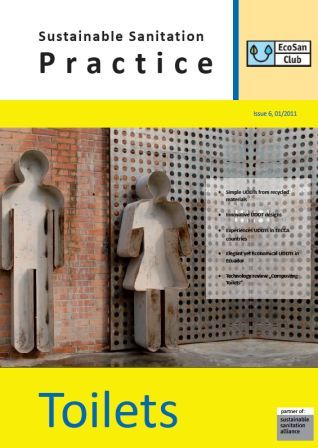
Published in: 2011
Publisher:
Sustainable Sanitation Practice (SSP), Issue 6. EcoSan Club, Austria
Author:
Ecosan Club (ed.)
Uploaded by:
SuSanA secretariat
Partner profile:
common upload
5287 Views
84 Downloads
Content - Summary
With issue 6 of Sustainable Sanitation Practice (SSP) on "Toilets" an overview on developments of different technologies for user interfaces are given. However, only contributions on Urine-diverting Dry Toilets (UDDTs) and urinals could be collected. The contributions present developments in different geographical regions: South America, East Africa and the Eastern Europe, the Caucasus and Central Asia (EECCA) countries. To imply another toilet technology, an abstract about a recently published technology review on compost toilets has been included.
Issue 6 contains the following articles:
Simple urine-diverting dry toilets built with recycled or readily available materials
Canaday, C.
Three different models of simple and inexpensive Urine-diverting Dry Toilets (UDDTs) are described: a portable one for squatting made from a barrel, another portable one made from wood and linoleum, and a permanent one for squatting made with palm wood. A simple, portable urinal made from two plastic bottles is also described. These can be made at very low cost, with abundant natural materials, salvaged post-consumer waste, and items that are readily purchased almost anywhere. They may be especially applicable in poor communities, slums, farms, disaster relief camps, and
temporary events, plus they may be used to train and screen users before building more eleelegant UDDTs. With these designs, conversion to UDDTs may be more a matter of paradigm shift than capital investment..
++++++++
Innovative urine diverting dry toilet (UDDT) designs from East Africa
Müllegger, E.
Toilets are commonly not viewed as being attractive or interesting. They are normally designed only to serve a certain purpose - a function called excreta management, which is already unattractive by itself. In combination with the need to develop low-cost solutions, design is often neglected. In East-Africa urine diverting dry toilets (UDDTs) are constructed since almost 15 years. But still most of the UDDTs have a similar design with very view adaptations. The paper presents different designs of UDDTs which are based on experiences from more than 10 years of sanitation system planning in the region.
++++++++
Experiences with urine diverting dry toilets (UDDTs) for households, schools and kindergarten in Eastern Europe, the Caucasus and Central Asia (EECCA)
Wendland, C., Deegener, S., Jorritsma, F.
This paper presents experiences with the implementation of urine diverting dry toilets (UDDTs) in the EECCA countries. In total 960 individual, 50 school and kindergarten and 7 public UDDTs have been implemented. A huge variety of different designs and materials of the sanitation facilities was applied by the WECF network partners. Experience based indications are given related to the success factors for acceptance of the individual toilets and for school sanitation projects.
++++++++
Elegant yet economical urine-diverting dry toilets in Ecuador
Thibodeau, C., Canaday, C.
During the summer of 2010, six Urine-diverting Dry Toilets (UDDTs) were built for rural families in the Andes Mountains, in the county of Tisaleo, Tungurahua, Ecuador. These were built with a simple, innovative design that uses conventional, readily available materials, including ceramic tiles on the ferrocement benches and floors to improve aesthetics and ease of cleaning. Each family contributed US$ 80 toward the moderate total unit cost of US$ 390. Of the six toilets, five were built in 16 days (by two experienced masons), as opposed to the sixth toilet in eight days (by the user, a student volunteer and a UDDT consultant). It was learned that quality control must be constant; contribution from the users is crucial for project success; and education and follow-up are essential.
++++++++
Technology review "Composting toilets"
Berger, W.
This abstract gives a short overview about the technology review „Basic overview about composting toilets (with or without urine diversion)”
Bibliographic information
Ecosan Club (ed.) (2011). Toilets. Sustainable Sanitation Practice (SSP), Issue 6. EcoSan Club, Austria
Filter tags
English Practitioners Sub-Saharan Africa Urine diversion dehydration toilets (UDDTs)














